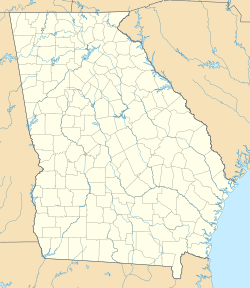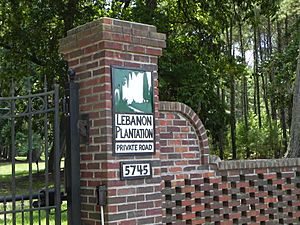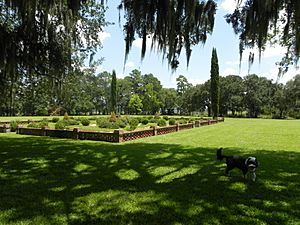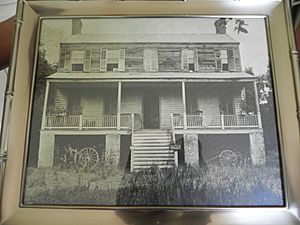Lebanon Plantation facts for kids
Quick facts for kids |
|
|
Lebanon Plantation
|
|
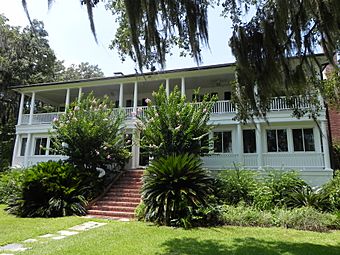
Main house at Lebanon Plantation
|
|
| Location | 5745 Ogeechee Road, Savannah, Georgia, U.S. |
|---|---|
| Area | 76 acres (31 ha) |
| Built | 1804, 1873 |
| Architectural style | Plantation Plain |
| NRHP reference No. | 79000704 |
| Added to NRHP | November 29, 1979 |
Lebanon Plantation is a special historical place located in Savannah, Georgia. This large estate covers more than 500 acres. It was first given to James Deveaux in 1756 and got its name from the many cedar trees growing there. Later, in 1802, Joseph Habersham bought the land.
In 1804, George W. Anderson bought the plantation and built the main house. This house was later rebuilt and added to after the American Civil War. During the war, Anderson's son, George Wayne Anderson, Jr., was in charge of Fort McAllister. After the fort was captured, Lebanon Plantation became his prison. It also served as the headquarters for the Fifteenth Army Corps of the US Army.
After the war, the main house was partly destroyed. George W. Anderson got it back in 1871 and had it repaired by 1873. He later divided some of the land for French immigrants to start a colony called L'Esperance, where they tried to grow grapes, but it didn't work out. In 1916, Mills Bee Lane bought the plantation. His family grew a new type of orange called the Savannah Satsuma. Today, Lebanon Plantation is still owned by the Lane–Morrison family, who have cared for it for three generations. It continues to be a working plantation, much like it has been for over 200 years.
Contents
Exploring Lebanon Plantation's Location
Lebanon Plantation is about 9 miles (14.5 km) southwest of downtown Savannah. It sits in Georgia's Lower Coastal Plain region. You can find it at 5475 Ogeechee Road, right off historic Highway 17.
A Journey Through Time at Lebanon
The Earliest Days of the Land
For thousands of years, Native Americans lived in this area. They often stayed here for parts of the year, as shown by old oyster shell piles found nearby. When European explorers arrived in the 1500s, the Yuchi and Creek tribe claimed this land.
In 1733, the first English settlers came to what is now Savannah. This area was part of the Yamacraw tribe's land, a group connected to the Creeks. James Oglethorpe, the leader of the English colonists, became friends with the Yamacraw chief Tomochichi. They peacefully agreed for the English to settle in the Savannah area.
Before the English, Spain had control over the Georgia coast in the 1600s through Native American allies. This led to fights with the growing English colonies to the north, especially Carolina. In 1702, Carolina's governor, James Moore Sr., attacked Spanish settlements in Florida. On his way, he destroyed Spanish Native American missions along the Georgia coast. This left the area mostly empty, creating a safe zone between Spanish Florida and English Carolina.
In the early 1730s, the English decided to settle the islands between Carolina and Florida. They received permission in 1732, and the first colonists sailed that same year. These English settlers in Savannah formed the beginning of what would become the colony and state of Georgia.
How Lebanon Plantation Began
The English were worried that Spain still wanted the area and might try to kick them out. So, they built several forts, including one near Lebanon Plantation by Noble Jones. A war, called the War of Jenkins' Ear, broke out in 1739. Jones helped the English in a raid in Florida and in defending Frederica in 1742. When the war ended in 1748, the Spanish threat to the new colony was mostly gone.
The land that became Lebanon Plantation was given to James Deveaux in 1756. Later, in 1758, Phillip Delegal received another 500 acres, which eventually became part of the plantation.
Life at Lebanon Before the Civil War
Early on, Georgia's rules did not allow slavery. So, many landowners used indentured servants, who worked for a set time to pay off a debt, to farm their fields. But in 1749, the rules changed, and slavery was allowed. Many plantations then started using forced labor to make their farms profitable.
During the American Civil War (1861–1865), Lebanon Plantation was taken over by the Union Army. It became the headquarters for the Fifteenth Army Corps, led by General William Babcock Hazen. After Fort McAllister was captured, its commander, George Wayne Anderson Jr., was held prisoner in his own home at Lebanon.
General Hazen and Lt. Col. Strong invited General William Tecumseh Sherman to dinner to celebrate their victory. In a kind gesture, General Hazen also invited Major Anderson to join them. During the meal, Anderson and General Sherman had a lively discussion about the battle and the bravery of the soldiers.
Lebanon in the 1900s
The main house at Lebanon Plantation shows how a home can grow and change over many years. It was built before the Civil War, partly destroyed, and then rebuilt and updated. It still keeps its unique look and feel. The front porch, added in the 1900s, blends with the older parts of the house from the 1800s.
Lebanon Plantation Today
Today, Lebanon Plantation is home to Verdant Kitchen, a company started in 2012. They make drinks, baked goods, candies, snacks, and spices. You can find their products at local markets, online, and in special food stores.
They grow ginger, turmeric, and galangal (also known as Thai ginger) right at Lebanon Plantation. These crops are then prepared in a special organic facility on the plantation. The final products are made in their kitchen in Atlanta.
See also
Gallery


